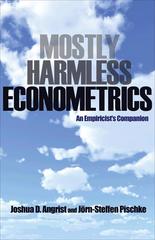Here is the quention
This part asks a series of questions about the relationship between dthree, traffic death rates (number of traffic deaths per million miles driven), unem, unemployment rates, and admn, a dummy variable that equals 1 if a State in a given year has administrative laws such as driver licenses can be suspended for drunk driving. Data was gathered for these variables for the 48 contiguous States of the United States (Hawaii, Alaska and Washington D.C. are not included) for the years 1980 and 2004. The average death rate across all states was 3.55 in 1980 and was 1.51 in 2004 Suppose we are interested in the following regression relationship dthreeit = Bo + dod2+ + Bjadmnit + Brunemit + ai + Wit, where t = 1 is 1980 and t = 2 is 2004. The variable d2, is a dummy variable that equals 1 if t = 2 (2004). The total error depends on the State specific heterogeneity, ai, and an idiosyncratic error, Wit. We would expect ai to be correlated with admnit because states with higher than normal traffic death rates may be under pressure to pass drunk driving laws. You can assume that wit is not correlated with admnit and unemit. Consider four options for estimating the parameters B1 and B2. For the first two options we estimate separate regressions for 1980 (t = 1) and 2004 (t = 2) using OLS: dthrtem1 = Bo + Biadmni1 + Bzunemil + ai + Wil, dthree;2 = do + Bjadmni2 + Bzunemiz + ai + 2:2. For the third option we can pool the data from both years and estimate the panel model dthreeit = Bo + dod2+ + Bjadmnit + Bzunemit + ai + Wit, using OLS (i.e. the Pooled-OLS estimators). Finally, we can apply the first difference transforma- tion to the panel model and estimate the transformed model Adthreei = do + 31admni + B2Aunemi + Sui. by OLS (i.e. the First-Differences estimators). a) What are the interpretations of the do, Bi and 32 parameters? If you used First-Differences to estimate these parameters, would this change the interpretation? Why or why not?The four estimation methods yielded the following results given in Table 1. Heteroskedasticity robust standard errors are given in parentheses. 13) Table 1: Estimates for Death Rate Model Using the Years 1980 and 2004 1980 only 2004 only Pooled OLS First Differences A 61 (661m)" 1.56 .0065 .159 -.308 (.833) (.154) (.224) (.238) 62 (unem) .070 .028 .019 .021 (.077) (.062) (.057) (.071) 60 (d2) NA NA -219 -175 (.222) (.265) obs 48 48 96 48 Provide an explanation for why the estimates of ll are so different across the four estimation methods. (6 points) Which estimator of 61 do you prefer and why? (4 points) Is your preferred estimator of 51 statistically signicant at the 10% level? Why or why not? (2 points) Is it practically signicant? Why or why not? (2 points) Using the First Differences estimator, test the null hypothesis that mean traffic death rates did NOT fall from 1980 to 2004 (holding admn and unemp constant) against the hypothesis that mean traffic death rates did fall. Write down the null and alternative hypotheses in terms of the relevant parameter and carry out your test at the 5% level. (6 points) What do you conclude? (1 point) From the Table we see that First Differences is based on only one year's worth of data (obs : 48). Someone suggests that FixedEffects is a better estimation option than First Differences because there is unlikely to be much, if any, correlation between uit at years 1980 and 2004 because shocks to traffic death do not last for 25 years. Suppose it is true that 111-1 (1980) is uncorrelated with U72 (2004). Can FixedEffects be better than First Differences? Why or why not? (6 points)








